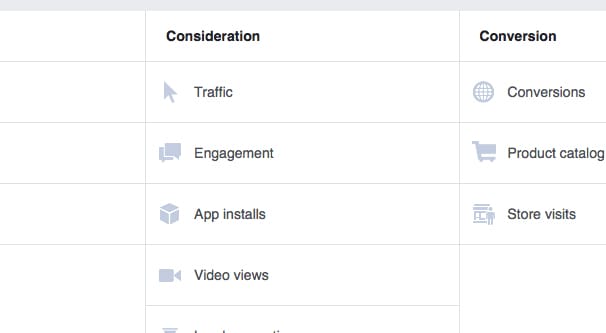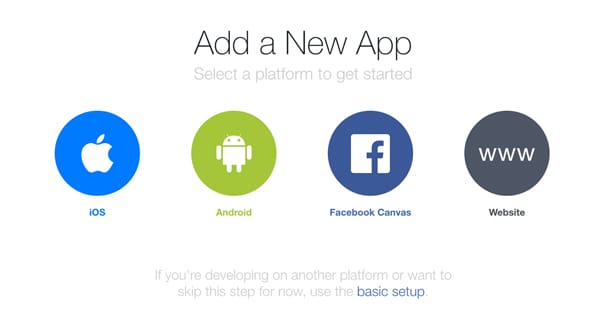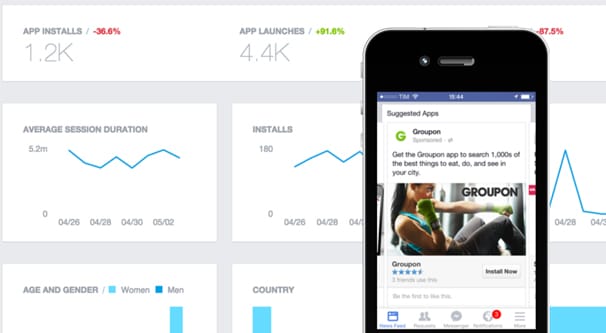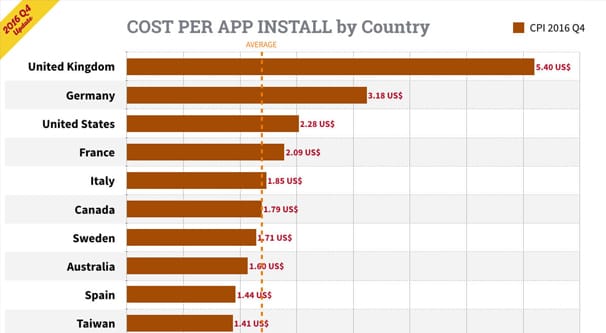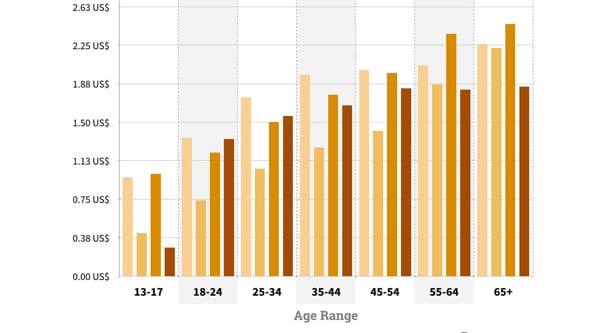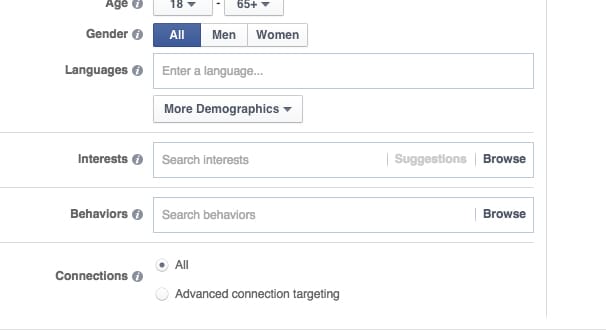 Written by ContentPowered.com
Written by ContentPowered.com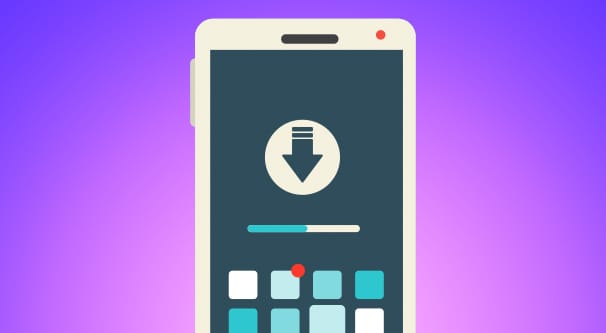
One of the least known and least used styles of ads on Facebook is the app install ad. As you might imagine, the core focus of the ad is to get people to install your app. In order to use it, you have to jump through a few hoops, but it can be well worth it for the right kind of business.
Pay Per App Install Ad Prerequisites
There are two types of app install ads you can run on Facebook. One of them is an ad type that is focused on putting your app ad in front of as many people in your audience as possible. It’s cheaper to run on a per-hit basis, but you’re paying with the oCPM model Facebook uses for their brand awareness and basic click ads. This means that if your ad or your app are not sufficiently compelling, you can end up paying more for the exposure and get fewer conversions.
The other type of ad is the one we’re primarily talking about, and is the pay per install version. You run ads that are exposed to as many people in your audience as possible, with an emphasis on showing it to the people who are most likely to install on the spot. You get exposure, including likes, shares, and comments for free, and you’re only charged when someone actually installs your app.
“If your mobile app is connected to Facebook (through the Facebook SDK, mobile measurement partner or other connection) and you’ve chosen to report on this app event, this metric counts when the app event is reported, attributed to your ads. The metric counts when people opened your app for the first time.” From the Facebook help center.
What this means is that you’re only charged when an app install is successfully reported from within the app, which only happens when the app is first booted up in a way that it can report. This means app installs in a sandboxed or no-internet environment won’t count.
According to this help thread, in order to be able to create pay-per-install ads on Facebook, you need to have an app. This is, well, pretty obvious, right? You can’t pay for app installs if you don’t have an app to install.
However, this doesn’t mean you need an app in the Google Play Store or the Apple App Store. It means you need to have an app that is part of the Facebook SDK. If you don’t use Facebook integration in your app, it can’t report installations to Facebook, and thus you can’t use that type of ad. This means your app needs to make use of the Facebook marketing API, which in turn means you need to keep it up to date as Facebook changes that API over time.
Using the Facebook marketing API and SDK also open up mobile engagement ads. If your app uses Facebook engagement as a core part of it, and you want to incentivize people to use it, you can run mobile app engagement ads. I’m going to gloss over those, though, since this post is primarily about app install ads.
The restriction of using the Facebook SDK only applies to app engagement and app install ads. If all you want are basic oCPM ads that point to a Google Play or Apple Store link, you can do that just fine. You just won’t be able to see any app-based analytics in Facebook Insights or in your ads manager; just your exposure and conversion metrics and costs.
To learn more about the Facebook marketing API, you can read all about it in their documentation here.
One More Hoop
There’s a bit more to the story than the prerequisites section tells. See, if you want to run pay-per-install ads, you need to verify that you are actually getting valid installs on your app. This means you cannot launch a new app using these ads. At least, you can’t do it if you haven’t already used a testing group to install and report those installations.
Essentially, Facebook wants to cut down on the number of fraudulent, malware, or spam apps that go through the app stores. They don’t want to be party to advertising those low quality apps, so they limit who can advertise in their most effective form of app advertisement.
Basically, you need to have a fully functional app that uses the Facebook marketing API and integrates reporting. Then you need that app to exist on the storefronts and be available for download. You need people to actually download and open the app for use, which will trigger the installation event to report it to Facebook.
I’m not sure how many reported installations you need minimum, there doesn’t seem to be a consistent metric published anywhere. Facebook wants “enough” installations that they can verify that your app is legitimate. It’s likely more than a typical small dev team or individual asset flipper would be able to do on their own, but not such a huge amount that smaller apps are left out in the dust.
Once your app is published and you’ve sent data to Facebook through the marketing API, they will verify your data. They will check to make sure that your account ID is valid, your app ID is accurate, and that your mobile store entry matches that data. They will also scan the installations and make sure they aren’t fraudulent. In other words, you can’t game the system by installing the app on a handful of devices you own or that have obviously fake information associated with them.
Only once Facebook finally verifies all of that information will you be allowed to create pay-per-install ads for your app. And yes, every time you launch a new app, you will have to go through all of those hoops again. It’s a per-app verification, not a per-account verification. Every app you want to use with pay-per-install ads will need this verification.
The Cost of Install Ads
AdEspresso, midway through 2017, published a report about the cost of various types of Facebook ads across various metrics. I’ve summarized the salient points about cost-per-install ads here. You can read the full report on their site.
First of all, you can see the data divided by country. By far the most expensive country to target was the United Kingdom, at $5.40 USD per installation. Germany is second, with $3.18, and the USA follows with $2.28. Other European countries come after that, ranging from $1.44 for Spain to $2.09 for France. South America comes in after that, with areas like Colombia pulling $.73 per install and Brazil down at $.44 per install. As you might expect, the larger markets for Facebook have more competition, and thus more cost per installation. If you’re in a South American market and can take advantage of those low costs, it’s worth your time to invest in setting up these ads.
The cost for app installs as divided by age range are all relatively within the same brackets. It’s very cheap – under $.40 per install – to market to minors between 13 and 17 years old. The 18-24 bracket is up a bit above $1.25, and the 25-34 bracket is just a hair above $1.50. From there, all of the higher age brackets hover between $1.50 and $1.80, making them more or less identical. A little variation in your audience and their level of interest can swing this price up or down form the average very easily.
As far as gender segmentation goes, it’s easier to market to women than to men; men cost closer to $1.60, while women are only $1.21. Whether this is because of the relative number of apps aimed at the gender in question, the number of ads advertising apps to those genders, or just some sexist wage gap effect, I couldn’t tell you. The data also doesn’t cover the ongoing trend of nonbinary people, which Facebook is slowly starting to support, so if you’re working in a particular niche – Trans and nonbinary ally apps – you may have a different result.
Ad placement is an interesting breakdown. When you run app install ads on Facebook, you can put them in the general audience network, on the mobile newsfeed, or on Instagram. Instagram, you would expect to be higher, because most Instagram users are mobile users, but that’s not the case. Instagram ads came in at $1.10 per install, while the audience network was $.62 per install. The mobile news feed, however, was premium placement, with $1.75 per install. I chalk this up to how many people are advertising on the mobile news feed versus the other options. Obviously, the desktop feed is harder to push a mobile app since many of the users there are on desktop devices.
The monthly breakdown isn’t too surprising. Costs are relatively static throughout the year, ranging from about $1 at the low point in April, up to an average of $1.40 throughout most of the year. The average is pulled up dramatically by November, which had costs almost to $2.80. This is pretty obviously due to the Xmas season and Black Friday pulling up pressure on advertisers. The cost breakdown by day of the week is pretty much static as well, around $1.80 per install every day. Technically Wednesday is the lowest and Monday is the highest, but when the difference is a couple of pennies, who cares?
Cost per device is the last metric that’s worth looking at. Android phones come in at $.61 per install, which is pretty low, but that jives with the prevalence of Android phones. Android tablets are slightly cheaper at $.53 per install, which is pretty low and is the cheapest market of all those measured. iPods, which have been dropping in usage over the last few years, come in at $.91 per installation. iPhones, which are incredibly popular and rigid with their marketing practices, are all the way up at $2.31 per install. Only iPads are more costly, at $2.57. Basically, Androids are cheap and Apple devices are expensive. It makes sense, given that Apple devices are the higher end luxury devices, while Android caters to every demographic with some device or another.
Of course, your costs will vary depending on your app, your target demographic, and your budget.
How to Decrease Pay-Per-Install Costs
If you want to decrease the cost of your ads, the number one way is to more appropriately target your audience. The fewer wasted views, the higher your quality score is going to be, and the lower your costs will be. Obviously, you need to comply with the various best practices for ads, like the use of text, but targeting will generally have the largest effect.
First, target by hobbies. You know your audience has a hobby related to whatever your app is doing, so go ahead and target those hobbies with your app ads. A fitness tracking app might target people who are interested in health, fitness, weight loss, and dieting. A game might target people interested in mobile games and video games.
Second, target by profession. If you have a productivity app, you might want to target self-employed individuals, people in management positions, and people whose time management skills are a survival skill.
Third, make use of lookalike audiences. You can build an audience out of the people who have actually installed your app, as reported by the marketing SDK. Build a lookalike audience out of those and you’ll reach the people who are just like your users, but who aren’t yet users.
And, of course, you should always limit your geographic location to areas where your app is available and useful. It does you no good to offer an app that does English-to-French translations to people who live in France, right? They already know the language.

